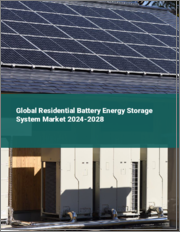
|
시장보고서
상품코드
1497734
세계의 주택용 에너지 저장 시장 : 시장 규모, 점유율 분석 - 동향 및 예측(2024-2030년)Residential Energy Storage Market Report: Size and Share Analysis, Trends, Forecasts (2024-2030) |
||||||
시장 하이라이트
주택용 에너지 저장 시장은 2023년에 8억 130만 달러로 평가되었고, 27.9%의 연평균 복합 성장률(CAGR)로 성장할 전망이며, 2030년에는 42억 4,030만 달러로 확대될 것으로 예측됩니다. 신재생 에너지원의 이용이 중시되게 된 것이 업계의 성장을 가속하는 주요 요인입니다.
지역 에너지 저장(CES) 시스템은 업계에서 관찰되는 주요 동향입니다. CES는 혁신적인 스마트 그리드 기술이며 품질, 제어 안정성, 신뢰성 측면에서 배전망의 다양한 이점을 제공합니다. CES는 일반적으로 DER 및 고객과 가까운 그리드 주변에 설치됩니다.
주요 인사이트
2023년의 업계 점유율은 유럽이 45% 이상으로 최대였으며, 향후 10년간도 최대로 지속될 것으로 보입니다. 이는 옥상 태양광 발전의 급속한 보급, 배터리 시스템에 대한 30%의 정부 보조금, 다수의 기업의 존재, 도시화율의 상승 등이 배경에 있습니다.
아시아태평양은 업계에 기여가 큽니다. 이는 인구 급증, 소비 지출 증가, 신재생 에너지 필요성 증가, 엄청난 고객층과 가처분소득 향상, 혁신적 기술 수용 증가로 인한 것입니다.
고객 소유 카테고리는 2023년에 업계를 선도하였고 앞으로도 계속 이어갈 것으로 보입니다. 이는 킬로와트 시간당 전력 가격 하락, 자급 자족 달성의 중시 증가, 옥상 태양광 발전 솔루션에 대한 요구 증가 등 소비자 소유의 ESS의 많은 이점 때문입니다.
2023년에는 온그리드 카테고리가 가장 큰 기여자가 되었으며, 향후 10년간 이 추세가 지속될 것으로 보입니다. 온그리드 시스템에서는 발전된 잉여 전력을 송전망을 소유한 전력회사로 송전함으로써 개인이 크레딧을 회수하고 연말에 그것을 인출할 수 있습니다.
2023년에는 6-10kW의 카테고리가 55% 이상의 점유율을 차지하였습니다. 이는 에너지 사용량 증가, 장시간의 정전 발생률의 상승, 보다 안정된 전력량에 대한 요구의 급증, 전력망 시스템의 장애 등이 원인으로 생각됩니다.
리튬이온 카테고리는 2023년에 75% 이상의 점유율로 업계를 지배했으며 향후도 지배적일 것으로 전망됩니다. 이는 이러한 배터리가 더 안정적이고 일정하며 여러 번 재충전할 수 있기 때문입니다.
본 보고서에서는 세계의 주택용 에너지 저장 시장을 분석하고, 시장의 기본 구조 및 최신 정세와 주요 촉진 및 억제요인, 세계 전체 및 지역별 주요 국가 시장 규모의 동향 전망(금액 기준, 2017-2030년), 기술별, 유틸리티별, 연결 유형별, 소유 형태별, 운용 형태별 상세 동향, 현재 시장 경쟁 구도, 주요 기업 프로파일 등의 정보를 전해드립니다.
목차
제1장 조사 범위
제2장 조사 방법
제3장 주요 요약
제4장 시장 지표
제5장 업계 전망
- 시장 역학
- 동향
- 성장 촉진요인
- 억제요인 및 과제
- 성장 촉진요인 및 억제요인의 영향 분석
- 신형 코로나 바이러스 감염(COVID-19)의 영향
- Porter's Five Forces 분석
제6장 세계 시장
- 개요
- 시장 수익 : 기술별(2017-2030년)
- 시장 수익 : 유틸리티별(2017-2030년)
- 시장 수익 : 접속 유형별(2017-2030년)
- 시장 수익 : 소유 형태별(2017-2030년)
- 시장 수익 : 운용 형태별(2017-2030년)
- 시장 수익 : 지역별(2017-2030년)
제7장 북미 시장
- 개요
- 시장 수익 : 기술별(2017-2030년)
- 시장 수익 : 유틸리티별(2017-2030년)
- 시장 수익 : 접속 유형별(2017-2030년)
- 시장 수익 : 소유 형태별(2017-2030년)
- 시장 수익 : 운용 형태별(2017-2030년)
- 시장 수익 : 국가별(2017-2030년)
제8장 유럽 시장
제9장 아시아태평양 시장
제10장 라틴아메리카 시장
제11장 중동 및 아프리카 시장
제12장 미국 시장
- 개요
- 시장 수익 : 기술별(2017-2030년)
- 시장 수익 : 유틸리티별(2017-2030년)
- 시장 수익 : 접속 유형별(2017-2030년)
- 시장 수익 : 소유 형태별(2017-2030년)
- 시장 수익 : 운용 형태별(2017-2030년)
제13장 캐나다 시장
제14장 독일 시장
제15장 프랑스 시장
제16장 영국 시장
제17장 이탈리아 시장
제18장 스페인 시장
제19장 일본 시장
제20장 중국 시장
제21장 인도 시장
제22장 호주 시장
제23장 한국 시장
제24장 브라질 시장
제25장 멕시코 시장
제26장 사우디아라비아 시장
제27장 남아프리카 시장
제28장 아랍에미리트(UAE) 시장
제29장 경쟁 구도
- 시장 진출기업 및 제공 품목의 일람
- 주요 기업의 경쟁 벤치마킹
- 주요 기업의 제품 벤치마킹
- 최근의 전략 전개 상황
제30장 기업 프로파일
- Panasonic Industry Co. Ltd.
- sonnen GmbH
- VARTA AG
- Enphase Energy Inc.
- Samsung SDI Co. Ltd.
- Saft Groupe SAS
- LG Energy Solution Ltd.
- BYD Company Limited
- Huawei Technologies Co. Ltd.
- Eaton Corporation plc
- Solar Technology AG
- GoodWe Technologies Co. Ltd.
- Hitachi Energy Ltd.
제31장 부록
AJY 24.06.28Market Highlights
The residential energy storage market was valued at USD 801.3 million in 2023, which will increase to USD 4,240.3 million, propelling at a 27.9% CAGR, by 2030.
The rising emphasis on employing renewable energy sources is a major factor driving the growth of the industry.
The utilization of renewable energy sources to allow a more dependable and effective energy supply is rising.
Many countries have openly stated their pledge to attain carbon neutrality in the wake of the rising worries regarding the consequences of the growing atmospheric concentrations of CO2 and various other GHGs on the global climate.
By shifting to renewable energy sources, humanities can largely decrease their carbon footprint, therefore aiding the overarching aim of carbon neutrality.
Community energy storage systems are the major trend being observed in the industry.
Community energy storage (CES) is an innovative smart grid technology that offers different advantages of distribution grids, in terms of quality, control stability, and reliability.
This method has become an important part of modern microgrids because it provides advantages to both consumers and utilities.
It simplifies the effects of the sporadic output of DERs, counting PVs; and various other smart grid components, such as EVs, and incorporates them into the smart grid.
CES is generally placed at the grid periphery, which is close to DERs and customers.
Key Insights
Europe was the largest contributor to the industry in 2023, with over 45% share, and it will further remain the largest throughout this decade.
This will be because of the rapid rooftop solar power acceptance, a 30% government grant for the battery system, the existence of many players, and the rising rate of urbanization.
APAC is a significant contributor to the industry.
This is ascribed to the surging populace, increasing consumer expenditure, rising need for renewable energy, massive customer base and its improving disposable salary, and mounting acceptance of innovative technologies.
The customer-owned category led the industry in 2023, and it will remain leading in the coming years.
This is attributed to the numerous benefits of consumer-owned ESSs, including decreased power price per kilowatt-hour; the increasing emphasis on achieving self-sufficiency, and the mounting need for rooftop PV solutions.
The on-grid category was the largest contributor in 2023, and it will continue this trend throughout this decade.
With on-grid systems, the extra electricity produced can be transferred to the utility that owns the grid, enabling the individual to collect credit, which can be withdrawn at the end of the year.
The 6 to 10 kW category accounted for over 55% share in 2023.
This can be because of the increasing energy usage, rising incidence of long power outages, surging need for a better amount of stable power, and faults in grid systems.
The lithium-ion category dominated the industry in 2023, with more than 75% share, and it will remain dominating in the coming years.
This is because such batteries are more dependable and constant and can be recharged many times.
The industry displays strong competition, with the presence of many large and mid-sized companies.
Table of Contents
Chapter 1. Research Scope
- 1.1. Research Objectives
- 1.2. Market Definition
- 1.3. Analysis Period
- 1.4. Market Size Breakdown by Segments
- 1.4.1. Market size breakdown, by technology
- 1.4.2. Market size breakdown, by utility
- 1.4.3. Market size breakdown, by connectivity type
- 1.4.4. Market size breakdown, by ownership type
- 1.4.5. Market size breakdown, by operation type
- 1.4.6. Market size breakdown, by region
- 1.4.7. Market size breakdown, by country
- 1.5. Market Data Reporting Unit
- 1.5.1. Value
- 1.6. Key Stakeholders
Chapter 2. Research Methodology
- 2.1. Secondary Research
- 2.1.1. Paid
- 2.1.2. Unpaid
- 2.1.3. P&S Intelligence database
- 2.2. Primary Research
- 2.3. Market Size Estimation
- 2.4. Data Triangulation
- 2.5. Currency Conversion Rates
- 2.6. Assumptions for the Study
- 2.7. Notes and Caveats
Chapter 3. Executive Summary
Chapter 4. Market Indicators
Chapter 5. Industry Outlook
- 5.1. Market Dynamics
- 5.1.1. Trends
- 5.1.2. Drivers
- 5.1.3. Restraints/challenges
- 5.1.4. Impact analysis of drivers/restraints
- 5.2. Impact of COVID-19
- 5.3. Porter's Five Forces Analysis
- 5.3.1. Bargaining power of buyers
- 5.3.2. Bargaining power of suppliers
- 5.3.3. Threat of new entrants
- 5.3.4. Intensity of rivalry
- 5.3.5. Threat of substitutes
Chapter 6. Global Market
- 6.1. Overview
- 6.2. Market Revenue, by Technology (2017-2030)
- 6.3. Market Revenue, by Utility (2017-2030)
- 6.4. Market Revenue, by Connectivity Type (2017-2030)
- 6.5. Market Revenue, by Ownership Type (2017-2030)
- 6.6. Market Revenue, by Operation Type (2017-2030)
- 6.7. Market Revenue, by Region (2017-2030)
Chapter 7. North America Market
- 7.1. Overview
- 7.2. Market Revenue, by Technology (2017-2030)
- 7.3. Market Revenue, by Utility (2017-2030)
- 7.4. Market Revenue, by Connectivity Type (2017-2030)
- 7.5. Market Revenue, by Ownership Type (2017-2030)
- 7.6. Market Revenue, by Operation Type (2017-2030)
- 7.7. Market Revenue, by Country (2017-2030)
Chapter 8. Europe Market
- 8.1. Overview
- 8.2. Market Revenue, by Technology (2017-2030)
- 8.3. Market Revenue, by Utility (2017-2030)
- 8.4. Market Revenue, by Connectivity Type (2017-2030)
- 8.5. Market Revenue, by Ownership Type (2017-2030)
- 8.6. Market Revenue, by Operation Type (2017-2030)
- 8.7. Market Revenue, by Country (2017-2030)
Chapter 9. APAC Market
- 9.1. Overview
- 9.2. Market Revenue, by Technology (2017-2030)
- 9.3. Market Revenue, by Utility (2017-2030)
- 9.4. Market Revenue, by Connectivity Type (2017-2030)
- 9.5. Market Revenue, by Ownership Type (2017-2030)
- 9.6. Market Revenue, by Operation Type (2017-2030)
- 9.7. Market Revenue, by Country (2017-2030)
Chapter 10. LATAM Market
- 10.1. Overview
- 10.2. Market Revenue, by Technology (2017-2030)
- 10.3. Market Revenue, by Utility (2017-2030)
- 10.4. Market Revenue, by Connectivity Type (2017-2030)
- 10.5. Market Revenue, by Ownership Type (2017-2030)
- 10.6. Market Revenue, by Operation Type (2017-2030)
- 10.7. Market Revenue, by Country (2017-2030)
Chapter 11. MEA Market
- 11.1. Overview
- 11.2. Market Revenue, by Technology (2017-2030)
- 11.3. Market Revenue, by Utility (2017-2030)
- 11.4. Market Revenue, by Connectivity Type (2017-2030)
- 11.5. Market Revenue, by Ownership Type (2017-2030)
- 11.6. Market Revenue, by Operation Type (2017-2030)
- 11.7. Market Revenue, by Country (2017-2030)
Chapter 12. U.S. Market
- 12.1. Overview
- 12.2. Market Revenue, by Technology (2017-2030)
- 12.3. Market Revenue, by Utility (2017-2030)
- 12.4. Market Revenue, by Connectivity Type (2017-2030)
- 12.5. Market Revenue, by Ownership Type (2017-2030)
- 12.6. Market Revenue, by Operation Type (2017-2030)
Chapter 13. Canada Market
- 13.1. Overview
- 13.2. Market Revenue, by Technology (2017-2030)
- 13.3. Market Revenue, by Utility (2017-2030)
- 13.4. Market Revenue, by Connectivity Type (2017-2030)
- 13.5. Market Revenue, by Ownership Type (2017-2030)
- 13.6. Market Revenue, by Operation Type (2017-2030)
Chapter 14. Germany Market
- 14.1. Overview
- 14.2. Market Revenue, by Technology (2017-2030)
- 14.3. Market Revenue, by Utility (2017-2030)
- 14.4. Market Revenue, by Connectivity Type (2017-2030)
- 14.5. Market Revenue, by Ownership Type (2017-2030)
- 14.6. Market Revenue, by Operation Type (2017-2030)
Chapter 15. France Market
- 15.1. Overview
- 15.2. Market Revenue, by Technology (2017-2030)
- 15.3. Market Revenue, by Utility (2017-2030)
- 15.4. Market Revenue, by Connectivity Type (2017-2030)
- 15.5. Market Revenue, by Ownership Type (2017-2030)
- 15.6. Market Revenue, by Operation Type (2017-2030)
Chapter 16. U.K. Market
- 16.1. Overview
- 16.2. Market Revenue, by Technology (2017-2030)
- 16.3. Market Revenue, by Utility (2017-2030)
- 16.4. Market Revenue, by Connectivity Type (2017-2030)
- 16.5. Market Revenue, by Ownership Type (2017-2030)
- 16.6. Market Revenue, by Operation Type (2017-2030)
Chapter 17. Italy Market
- 17.1. Overview
- 17.2. Market Revenue, by Technology (2017-2030)
- 17.3. Market Revenue, by Utility (2017-2030)
- 17.4. Market Revenue, by Connectivity Type (2017-2030)
- 17.5. Market Revenue, by Ownership Type (2017-2030)
- 17.6. Market Revenue, by Operation Type (2017-2030)
Chapter 18. Spain Market
- 18.1. Overview
- 18.2. Market Revenue, by Technology (2017-2030)
- 18.3. Market Revenue, by Utility (2017-2030)
- 18.4. Market Revenue, by Connectivity Type (2017-2030)
- 18.5. Market Revenue, by Ownership Type (2017-2030)
- 18.6. Market Revenue, by Operation Type (2017-2030)
Chapter 19. Japan Market
- 19.1. Overview
- 19.2. Market Revenue, by Technology (2017-2030)
- 19.3. Market Revenue, by Utility (2017-2030)
- 19.4. Market Revenue, by Connectivity Type (2017-2030)
- 19.5. Market Revenue, by Ownership Type (2017-2030)
- 19.6. Market Revenue, by Operation Type (2017-2030)
Chapter 20. China Market
- 20.1. Overview
- 20.2. Market Revenue, by Technology (2017-2030)
- 20.3. Market Revenue, by Utility (2017-2030)
- 20.4. Market Revenue, by Connectivity Type (2017-2030)
- 20.5. Market Revenue, by Ownership Type (2017-2030)
- 20.6. Market Revenue, by Operation Type (2017-2030)
Chapter 21. India Market
- 21.1. Overview
- 21.2. Market Revenue, by Technology (2017-2030)
- 21.3. Market Revenue, by Utility (2017-2030)
- 21.4. Market Revenue, by Connectivity Type (2017-2030)
- 21.5. Market Revenue, by Ownership Type (2017-2030)
- 21.6. Market Revenue, by Operation Type (2017-2030)
Chapter 22. Australia Market
- 22.1. Overview
- 22.2. Market Revenue, by Technology (2017-2030)
- 22.3. Market Revenue, by Utility (2017-2030)
- 22.4. Market Revenue, by Connectivity Type (2017-2030)
- 22.5. Market Revenue, by Ownership Type (2017-2030)
- 22.6. Market Revenue, by Operation Type (2017-2030)
Chapter 23. South Korea Market
- 23.1. Overview
- 23.2. Market Revenue, by Technology (2017-2030)
- 23.3. Market Revenue, by Utility (2017-2030)
- 23.4. Market Revenue, by Connectivity Type (2017-2030)
- 23.5. Market Revenue, by Ownership Type (2017-2030)
- 23.6. Market Revenue, by Operation Type (2017-2030)
Chapter 24. Brazil Market
- 24.1. Overview
- 24.2. Market Revenue, by Technology (2017-2030)
- 24.3. Market Revenue, by Utility (2017-2030)
- 24.4. Market Revenue, by Connectivity Type (2017-2030)
- 24.5. Market Revenue, by Ownership Type (2017-2030)
- 24.6. Market Revenue, by Operation Type (2017-2030)
Chapter 25. Mexico Market
- 25.1. Overview
- 25.2. Market Revenue, by Technology (2017-2030)
- 25.3. Market Revenue, by Utility (2017-2030)
- 25.4. Market Revenue, by Connectivity Type (2017-2030)
- 25.5. Market Revenue, by Ownership Type (2017-2030)
- 25.6. Market Revenue, by Operation Type (2017-2030)
Chapter 26. Saudi Arabia Market
- 26.1. Overview
- 26.2. Market Revenue, by Technology (2017-2030)
- 26.3. Market Revenue, by Utility (2017-2030)
- 26.4. Market Revenue, by Connectivity Type (2017-2030)
- 26.5. Market Revenue, by Ownership Type (2017-2030)
- 26.6. Market Revenue, by Operation Type (2017-2030)
Chapter 27. South Africa Market
- 27.1. Overview
- 27.2. Market Revenue, by Technology (2017-2030)
- 27.3. Market Revenue, by Utility (2017-2030)
- 27.4. Market Revenue, by Connectivity Type (2017-2030)
- 27.5. Market Revenue, by Ownership Type (2017-2030)
- 27.6. Market Revenue, by Operation Type (2017-2030)
Chapter 28. U.A.E. Market
- 28.1. Overview
- 28.2. Market Revenue, by Technology (2017-2030)
- 28.3. Market Revenue, by Utility (2017-2030)
- 28.4. Market Revenue, by Connectivity Type (2017-2030)
- 28.5. Market Revenue, by Ownership Type (2017-2030)
- 28.6. Market Revenue, by Operation Type (2017-2030)
Chapter 29. Competitive Landscape
- 29.1. List of Market Players and their Offerings
- 29.2. Competitive Benchmarking of Key Players
- 29.3. Product Benchmarking of Key Players
- 29.4. Recent Strategic Developments
Chapter 30. Company Profiles
- 30.1. Panasonic Industry Co. Ltd.
- 30.1.1. Business overview
- 30.1.2. Product and service offerings
- 30.1.3. Key financial summary
- 30.2. sonnen GmbH
- 30.2.1. Business overview
- 30.2.2. Product and service offerings
- 30.2.3. Key financial summary
- 30.3. VARTA AG
- 30.3.1. Business overview
- 30.3.2. Product and service offerings
- 30.3.3. Key financial summary
- 30.4. Enphase Energy Inc.
- 30.4.1. Business overview
- 30.4.2. Product and service offerings
- 30.4.3. Key financial summary
- 30.5. Samsung SDI Co. Ltd.
- 30.5.1. Business overview
- 30.5.2. Product and service offerings
- 30.5.3. Key financial summary
- 30.6. Saft Groupe SAS
- 30.6.1. Business overview
- 30.6.2. Product and service offerings
- 30.6.3. Key financial summary
- 30.7. LG Energy Solution Ltd.
- 30.7.1. Business overview
- 30.7.2. Product and service offerings
- 30.7.3. Key financial summary
- 30.8. BYD Company Limited
- 30.8.1. Business overview
- 30.8.2. Product and service offerings
- 30.8.3. Key financial summary
- 30.9. Huawei Technologies Co. Ltd.
- 30.9.1. Business overview
- 30.9.2. Product and service offerings
- 30.9.3. Key financial summary
- 30.10. Eaton Corporation plc
- 30.10.1. Business overview
- 30.10.2. Product and service offerings
- 30.10.3. Key financial summary
- 30.11. Solar Technology AG
- 30.11.1. Business overview
- 30.11.2. Product and service offerings
- 30.11.3. Key financial summary
- 30.12. GoodWe Technologies Co. Ltd.
- 30.12.1. Business overview
- 30.12.2. Product and service offerings
- 30.12.3. Key financial summary
- 30.13. Hitachi Energy Ltd.
- 30.13.1. Business overview
- 30.13.2. Product and service offerings
- 30.13.3. Key financial summary
Chapter 31. Appendix
- 31.1. Abbreviations
- 31.2. Sources and References
- 31.3. Related Reports



















